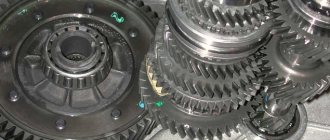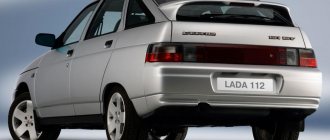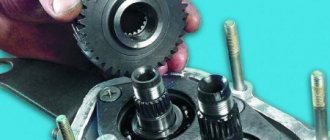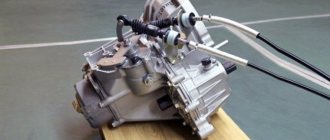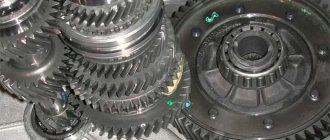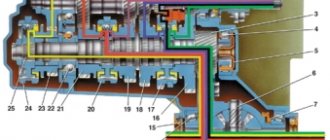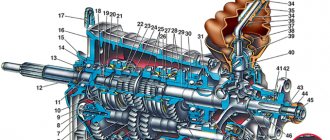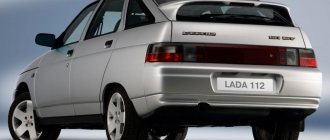For a long time, the gearbox was mechanical, but the non-trivial shift mechanism inherent in this type of transmission forced designers to search for alternative methods of shifting gears.
And their efforts were not in vain - the family of gearboxes was replenished first with automatic transmissions, and then with other varieties - robotic, variable, sequential.
But it just so happens that the average car enthusiast can only talk with confidence about manual and automatic. Much fewer motorists are aware of what a CVT or robotic transmission is. And there are very few who know how the sequential box works and works. We decided to fill this gap in automotive education.
What is a Sequential Box
A sequential gearbox on a car means that the driver selects gears not randomly, but in a clear sequence, moving the gearbox selector in one direction. This is the difference between this box and the “mechanics”, where after squeezing the clutch the lever can be moved to any of the positions.
Such a gearbox is a relatively new invention, appearing in the early 90s of the 20th century. Initially, racing cars were equipped with these units: for example, BMW 3 Series sports cars from the motorsport division of the automaker. The choice of a sequential gearbox for equipping sports cars was dictated by test results: studies have shown that with the help of such a gearbox the driver can better control the car compared to a classic automatic transmission, while he still has the opportunity to influence the process of changing gears as effectively as “ mechanics." This advantage of the sequential unit is especially evident where it is necessary to change the driving speed sequentially.
The new gearbox gained the love of car owners, although some complained about some “slowness” of switching gearbox stages. But the second generation of sequential boxes solved this problem too.
Important: the sequential gearbox, like the automatic transmission, does not have a clutch pedal.
Appearance of the shift lever:
Shifting “up” increases the gear, “down” - downshifts. Some cars may also be equipped with steering wheel switches for driver convenience. The role of the clutch pedal is performed by a hydraulic mechanism under the control of an electronic control unit, the latter also takes over the switching if the box is operating in “full” automatic transmission mode.
Interesting: this type of gear shift is widespread in racing, the design of agricultural machinery, heavy-duty vehicles and motorcycles with a small number of transmission stages.
Scope of application of sequential automatic transmission
Initially, such boxes were indeed installed only on cars used in various motorsport disciplines. However, even today this type of transmission has no competitors in auto racing, allowing gear changes to be made as quickly as possible and without an intermediate drop in speed. A few tenths of a second (strictly speaking, at least half a second) is a lot where the winner is often separated from the runner-up by hundredths of a second. Add to this a hydraulic shift mechanism - and you get a truly high-speed transmission, albeit quite expensive.
But for more than two decades, automatic transmissions have also been installed on production cars. The BMW automaker turned out to be a pioneer here; currently, for example, the M3/M5 models from BMW or the Mercedes-Benz C-Class are equipped with such a box. Some people confuse such a transmission with an automatic transmission, calling it a “manual” version of an automatic transmission, which is fundamentally incorrect, and we have already talked about this. Owners of cars equipped with a sequential gearbox claim that driving a vehicle has become much easier, and precise engagement in gear depending on the driving mode is not required.
Many motorcycles are equipped with gearboxes that operate on the principle of sequential gear shifting, and this technology is more than 50 years old. Usually this is a lever switched by the foot, which has two positions: forward and backward. The neutral is located between them.
The sequential gearbox is also installed on agricultural vehicles (tractors, tracked vehicles). Here the shift lever is also located under the feet, like on motorcycles, but can also be installed on the steering wheel.
Finally, many models of heavy-duty trucks and other heavy special equipment are equipped with automatic transmission, in which the number of gears can exceed a dozen - it would be very difficult to control such a manual transmission.
Cam or sequential
By creating a sequential gearbox, the developers set a goal to reduce the interval between speed changes. Thanks to the design features of such a transmission, this is achieved by simplifying switching and eliminating operations with the clutch pedal. This is especially important for new and inexperienced drivers who have difficulty performing switching procedures correctly. But professionals will also appreciate the gearbox, thanks to its convenience and the ability to subtly sense and control the behavior of the car, using the maximum of its capabilities.
Design features
The sequential gearbox differs from other gearboxes in a number of design features. Firstly, the design is based on gears with straight teeth, which cannot be said about a manual gearbox. It has helical gears installed. It is in the straight teeth that the main advantage of the SKP lies. Such gears create virtually no friction. Secondly, the diameters of the gears are increased compared to those in the “mechanics”. Thirdly, the sequential gearbox uses a hydraulic servo drive. But car enthusiasts do not see the differences between a hydraulic servo drive and an “automatic” one. But this is fundamentally wrong; these designs have different operating principles and efficiency.
Other features include the fact that the shift lever is often located on the steering wheel. Instead of a lever there are buttons. In this case, the box operates either in standard mechanical or sports mode.
Advantages and disadvantages of a sequential box
The features of the sequential box and its design lead to obvious advantages:
- Ease of shifting and high gear change speed.
The ECU and hydraulics reduce shift times to 150ms, which is critical for professional racers. This result cannot be achieved by any, even the most advanced, classic manual or automatic transmission. In addition to speed, the sequential gearbox eliminates “missing” the desired gear, because the transition between them is carried out strictly sequentially.
- The speed of the car is not lost when switching.
When working with a manual transmission, the speed decreases slightly when changing gears. This is relevant for turbocharged engines, which manage to fall into the turbo hole while the driver is manipulating the transmission.
- Economy of the car.
- Ease of control thanks to the possibility of using steering wheel paddle shifters.
- Possibility of selecting modes - manual and fully automatic switching.
SMG gearbox: sequential transmission
As you know, at the initial stage in the automotive industry, only manual transmissions were used.
However, later engineers developed other types of transmissions, with the main goal being to make driving as easy as possible.
A real breakthrough was the emergence of an automatic transmission, which made it possible to select and change gears automatically, that is, without driver participation.
At the same time, the hydromechanical “automatic” did not supplant traditional mechanics for a number of reasons; manual transmissions continued to be refined, and the design was constantly improved. As a result, one of the varieties of manual transmission became the sequential gearbox.
In a nutshell, this transmission differs from analogues in that upshifts and downshifts are engaged only in a certain sequence. To put it simply, the driver of a car with a so-called sequential gearbox shifts strictly in order “up” to engage an upshift, or “down” to engage a downshift.
At the same time, with conventional mechanics, the driver can change gears according to the “search” principle, that is, arbitrarily. The main thing is that the gear matches the speed, etc. In practice, for example, you can start from second and immediately switch to fourth. A sequential checkpoint will not allow you to do this.
Design and principle of operation of a sequential gearbox
As already mentioned, a sequential gearbox (sometimes called a selective gearbox) is based on a simple manual transmission. However, there are also differences from manual transmission.
First of all, there is no clutch pedal, that is, the sequential gearbox is similar to a classic automatic transmission. Also, the design uses spur gears instead of helical ones. A separate ECU is responsible for “squeezing” the clutch instead of the driver; gear shifting is realized through a special hydraulic mechanism.
Such features make it possible to achieve high switching speeds, which is indispensable for sports cars, racing cars, etc. By the way, it is on such vehicles that a sequential gearbox is often installed, although this type of gearbox can also be found on civilian versions.
- The fact is that at high speed the car vibrates strongly, as a result of which it is quite difficult to engage the desired gear with conventional mechanics, and this must be done very quickly.
As you can see, the sequential gearbox is actually a more common “robot” today. Also, a conventional automatic transmission with a gas turbine engine, which has the ability to be manually controlled (Tiptronic), in this mode resembles the operation of a sequential gearbox.
Peculiarities
The sequential box has four main features:
- Consecutive speed changes.
The driver will not “miss” the desired gear and can always set exactly the gearbox stage that is needed at the moment, passing sequentially through the others.
- Lack of a third pedal – clutch.
Its role is performed by an electronic unit controlled by signals from numerous sensors.
- Use of spur gears in the design.
These elements have greater efficiency compared to conventional helical gears from a classic manual transmission, although they transmit less torque (to compensate for this, larger gears are installed).
- Gear shifting is carried out by hydraulic servos.
For comparison: a robotic gearbox uses electric drives. Therefore, calling a sequential box a “robot” is technically incorrect.
Advantages and disadvantages
Now you know what SKPP is and what sequentiality means. No? Yes, this is the sequence in translation. Here everything generally falls into place.
After watching the video and studying the features of such a gearbox, the question arises: is it worth taking a car with this gearbox? I’ll help you a little by telling you about the strengths and weaknesses of sequential systems.
Let's start with the advantages.
- High switching speed. The machine lives its own life, so sometimes it’s downright stupid and doesn’t do what you expect. The mechanics are more difficult to switch. The optimal speed is given by the automatic transmission. The electronic unit and hydraulics ensure minimal time spent switching from gear to gear. This is extremely important for professional motorsport.
- Convenience. Depressing the clutch pedal, getting into gear, and even at speed on a bad road is a dubious pleasure. The automatic transmission guarantees accuracy and comfort when switching. This is an indisputable fact.
Traditional box
On traditional gearboxes installed on most domestic cars, the neutral position of the gear lever is set in the middle. In order to get going, we depress the clutch and engage first gear. In the future, as the speed increases, it is recommended to switch them sequentially.
However, nothing prevents us from starting to move immediately in second speed if the road condition is normal and the engine is designed for such action. Trying to start the engine with a dead battery, we push the car and, to make it easier, we can immediately turn on the third, and even the fourth. Nothing prevents this. Reducing the speed to perform a maneuver, we slow down and go straight from fourth gear to second or first. If you mix it up, you can turn on the wrong speed while driving, which is far from harmless for a car.
In which passenger cars can you find a sequential gearbox?
Among the most common passenger cars, we can cite the example of a 1996 BMW with an SMG gearbox. The SMG1 and SMG2 systems were installed on the BMW third series with the S index. Since 2004, such a transmission has been installed on the BMW E60 M5. Also, sequential gearboxes were installed on certain models of Toyota Corolla, Mercedes C-class, BMW X5.
The layout of the sequential gearbox and its elements is shown in the figure:
In the figure: 1 – sequential gearbox control unit, 4 and 5 – indicator and mode switch, 7 – 6-speed gearbox, 12 – hydraulic unit, 10 – hydraulic drive, 11 – clutch.
Features of installing a sequential gearbox on VAZ cars
Many car enthusiasts purchase sequential gearboxes with a cam mechanism as an upgrade to their VAZ. Their appearance is approximately this.
As for a significant effect, one cannot count on this, since the dynamics of the car, judging by the reviews of the owners, increases slightly, although these boxes are called “sports”. In addition, the weight of such boxes is usually higher than traditional ones. Wide, massive gears with perpendicular teeth are used there to compensate for their low load capacity.
In addition, straight teeth increase the noise level of the gearbox. The actual service life of a homemade sequential gearbox is short. Such a gearbox can be installed if the car is expected to participate in sports competitions, but not for everyday driving around the city.
Basic misconceptions
Sequential transmission = robotic gearbox
This is probably the main misconception. Yes, these two gearboxes have servos, but in the sequential gearbox they are hydraulic, and in the robotic gearbox they are electric. And this is a technologically different implementation.
Sequential transmission is an automatic transmission
Most drivers make this conclusion based on the fact that almost all modern cars for regular use (not sports cars) that are equipped with such a transmission only work with an automatic transmission. This is a deep misconception, firstly, there are models where you can choose automatic shifting or manual shifting while driving. Secondly, remember Formula 1 racing and everything will immediately fall into place.
The principle of sequentiality
Sequential gear changes can be noted, for example, on motorcycles, where they are engaged with the foot. The neutral position there is most often located between first and second gear. The same mechanics are used on tractors and large trucks. Sequential switching is most widespread in the gearboxes of sports cars, where every millisecond counts and a reduction in speed when switching is unacceptable. The use of hydraulics allows us to further speed up this process and reduce it to a minimum.
The sequential mechanism is based on a conventional manual gearbox, somewhat complicated during the modernization process. The main feature is that it can be used to switch from a downshift to an upshift without reducing the speed of the vehicle, which invariably happens when operating a traditional gearbox.
What vehicles are equipped with automatic transmission?
Sequential gearboxes can be found on production cars, and not just on sports cars. For example, the BMW company has been producing models with such a transmission for several years. It has an individual drive rod, which provides a change of speeds. On the BMW M5 E60, the unit increases driving dynamics. If we take into account Russian-made cars, then automatic transmission was found on the VAZ-2108. A simplified unit was installed here, but with its help the driver could make maneuvers, switching from one speed to another.
